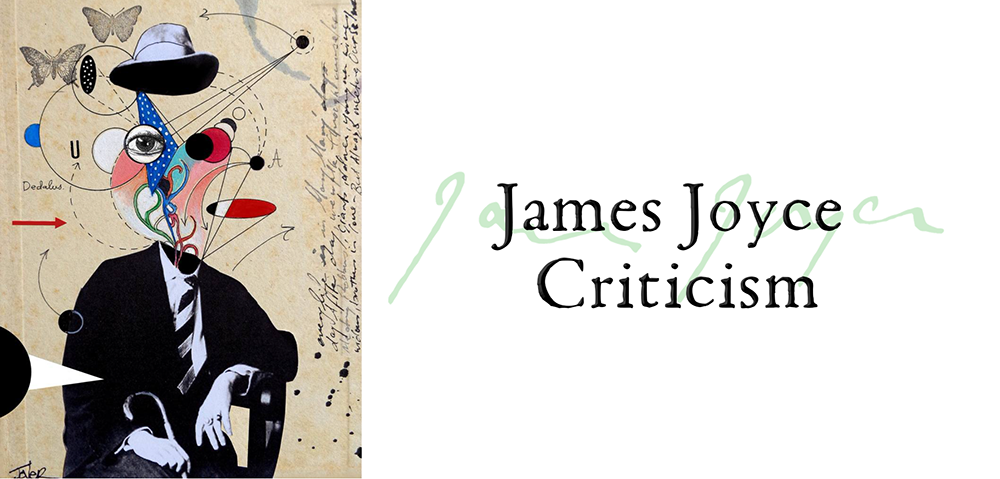Joyce Criticism: General 3: 2000-2019
- At March 26, 2022
- By Great Quail
- In Joyce
 0
0
General Joyce Criticism: 2000-2019
The works profiled below are criticism about Joyce and his entire oeuvre, rather than any specific work. This section details works written from 2000 to 2019. The books are listed by publication date. Clicking a cover image takes you to Amazon.com. When Brazen Head commentary is unavailable, the publisher’s summaries are usually reprinted. Many of these profiles contain links to detailed reviews published in the James Joyce Quarterly or other academic journals. Unfortunately, most of these are gated behind a JSTOR or Project MUSE paywall. If any knowledgeable Joyce reader would like to review, summarize, or provide additional information for any of these “uncommented” books, please drop us a line! Additional “general” criticism may be found by clicking the links below.
General Joyce Criticism
[Main Page | Criticism 1924-1979 | Criticism 1980-1999 | Criticism 2000-2019 | Criticism 2020-Present]
Joyce Effects: On Language, Theory and History
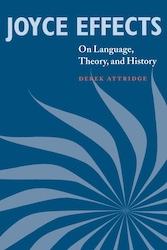
Joyce Effects: On Language, Theory and History
By Derek Attridge
Cambridge University Press, 2000
Available online at: Internet Archive
Publisher’s Description: Joyce Effects is a series of connected essays by one of today’s leading commentators on James Joyce. Joyce’s books, Derek Attridge argues, go off like fireworks, and one of this book’s aims is to enhance the reader’s enjoyment of these special effects. He also examines another sort of effect: the way Joyce’s writing challenges and transforms our understanding of language, literature, and history. Attridge’s exploration of these transforming effects represents fifteen years of close engagement with Joyce, and reflects the changing course of Joyce criticism during this period. Each of Joyce’s four major books is addressed in depth, while several shorter chapters take up particular theoretical topics such as character, chance and coincidence, historical writing and narrative as they are staged and scrutinized in Joyce’s writing. Through lively and accessible discussion, this book advances a mode of reading open to both the pleasures and the surprises of the literary work.
Contents:
1. Introduction: on being a Joycean
2. Deconstructive criticism of Joyce
3. Popular Joyce?
4. Touching ‘Clay’: Reference and reality in Dubliners
5. Joyce and the ideology of character
6. ‘Suck was a queer word’: Language, sex, and the remainder in A Portrait of the Artist as a Young Man
7. Joyce, Jameson, and the text of history
8. Wakean history: not yet
9. Molly’s flow: the writing of ‘Penelope’ and the question of women’s language
10. The postmodernity of Joyce: chance, coincidence, and the reader
11. Countlessness of live-stories: narrativity in Finnegans Wake
12. Finnegans awake, or the dream of interpretation
13. The Wake’s confounded language
14. Envoi; Judging Joyce.
Reviews: Christopher Powers’ review of Joyce Effects appeared in MLN, Vol. 116, No. 5 (December 2001), pp. 1098–1099, [Project MUSE paywall]: “Attridge’s insistence on deconstruction does not, happily, lead him to recondite and embattled prose: his essays are rigorous yet written with a jargonless lucidity that makes them as accessible as they are stimulating.”
Semicolonial Joyce
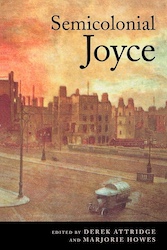
Semicolonial Joyce
Edited by Derek Attridge
Cambridge University Press, 2000
Publisher’s Description: James Joyce’s fiction constantly engages with an Ireland whose present and past is marked by the long struggle to achieve full independence from Britain. Semicolonial Joyce is the first collection of essays to address the importance of Ireland’s colonial situation in understanding Joyce’s work. The volume brings together leading commentators on the Irish dimension of Joyce’s writing to present a range of voices rather than a single position on a topic which has had a major impact on Joyce criticism in recent years. Contributors explore Joyce’s ambivalent and shifting response to Irish nationalism and reconsider his writing in the context of the history of Western colonialism. The essays both draw on and question the achievements of postcolonial theory, and provide fresh insights into Joyce’s resourceful engagement with political issues that remain highly topical today.
Contents:
- Marjorie Howes and Derek Attridge: Introduction
- Seamus Deane, “Dead ends: Joyce’s Finest Moments”
- Enda Duffy, “Disappearing Dublin: Ulysses, Postcoloniality and the Politics of Space”
- Majorie Howes, “Goodbye Ireland I’m Going to Gort: Geography, Scale and Narrating the Nation”
- Emer Nolan, “State of the Art: Joyce and Postcolonialism”
- Joseph Valente, “Neither Fish Nor Flesh: or How Cyclops Stages the Double-bind of Irish Manhood”
- David Lloyd, “Counterparts: Dubliners, Masculinity and Temperance Nationalism”
- Luke Gibbons, “Have You No Homes to Go To?: Joyce and the Politics of Paralysis”
- Katherine Mullin, “Don’t Cry for Me, Argentina: ‘Eveline’ and the Seductions of Emigration Propaganda”
- Willy Maley, “Kilt by kelt shell kithagain with kinagain: Joyce and Scotland”
- Elizabeth Butler Cullingford, “Phoenician Genealogies and Oriental Geographies: Joyce, Language and Race”
- Vincent J. Cheng, “Authenticity and Identity: Catching the Irish Spirit”
Reviews: Gregory Castle’s mixed review of Semicolonial Joyce appeared in English Literature in Translation, Vol. 45, No. 3 (2002), pp. 366–370, [Free Project MUSE PDF].
James Joyce: A Short Introduction
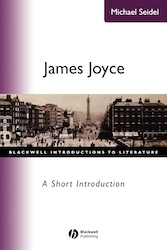
James Joyce: A Short Introduction
By Michael Seidel
Blackwell Publishing, 2002
Available online at: Internet Archive
Bob Williams: Michael Seidel is a professor at Columbia University, the author of many books on Joyce and others. He is also on the editorial board of The James Joyce Studies Annual. Appropriately to such a short book, the tone is brisk and the area to be covered marked out firmly. Seidel begins with Joyce’s fascination with language and observes that this fascination—an obsession—exercised Joyce’s creative genius throughout his life. Much the same can be said of his obsessions with Ireland and its church. The many obstacles of his youth became the fixtures with which he recreated the world. Inner conflicts, once acquired, are not easily dissolved; and Seidel describes convincingly the way that Joyce nurtured these conflicts in order both to commemorate and transform them. Rivalry and betrayal, the other springs of Joyce’s creative motions, also get ample treatment in proportion to the brevity of the book.
But what we have so far read are the indispensable preliminaries to the consideration of the individual books, and subsequent chapters concern themselves with the works in the order of their composition. There is a chapter each for Dubliners, Exiles and A Portrait of the Artist as a Young Man. The rest of the book is about Ulysses. The author promises little for the complex last work by Joyce, Finnegans Wake, but he sets out to cover the arc of creativity that culminates in the Wake. However, his quotations show that he is well acquainted with the Wake, and he begins on an incidental basis to do more than he proposes. He also points out that “It is one of the more powerful paradoxes in Joyce’s work that he sometimes says things more clearly in Finnegans Wake than he does elsewhere because he can get away with saying almost anything in Finnegans Wake.”
Seidel refurbishes Dubliners, dimmed for many modern readers by the similar effects of many later writers. The stories, extraordinarily Chekovian in spirit (although the evidence is strong that Joyce did not know Chekov’s stories at the time that he wrote Dubliners), are intricately connected and carefully constructed. Seidel develops this splendidly and adds important observations that are as fresh and original as the stories themselves.
Moving on to Portrait, some minor errors of small importance occur—the use, for example, of “drawing” instead of “drawling”—but the reference to Brother Michael (infirmarian at Clongowes) instead of to the dean of studies at University College Dublin is an error of a serious and inexplicable sort. Otherwise Seidel’s account of A Portrait of the Artist as a Young Man is vigorous and sustainedly interesting, although the excessive preoccupation with the villanelle is curious.
Joyce’s one play, Exiles, is the ugly duckling that never became a swan but remains the focus for valuable study. Seidel manages in a fittingly brief discussion to indicate the importance of Exiles without allowing it more virtues than it deserves.
The first chapter on Ulysses concerns narrative strategies. Seidel finds that there are four: customary third person narration, conversational narration, interior monologue, and, Joyce’s specialty, fourth estate narration (to give it Seidel’s name). The last presents the most difficulties, as it contains the book’s musings upon itself, and is mainly seen as eruptions of text only tenuously connected with the more customary narrative levels. In his examination of mixed modes, however, Seidel may be rowing into a fogbank. One of the perplexities of Joyce’s method regarding direct quotation—the use of the tiret (dash) rather than conventional quotation marks—is that the reader can never be altogether certain that direct speech has ended and another voice begun. To interpret, as Seidel does, that a closing phrase may be a thought rather than a spokenutterance is doubtful at best. (Joyce, a connoisseur of ambiguity, would have loved this confusion.) The “deficiencies” of the tiret over the quotation marks are especially marked in Finnegans Wake. Alas, in an otherwise successful effort to illustrate the fourth estate narrational device, Seidel again gets caught up in poor editing. The text gives us “Beniobenone” for “Beninobenone,” “Martha” for “Marta,” and “Karmelopulos” for “Karamelopulos.”
Seidel next examines the Homeric structure of Ulysses. He admits that this can be transparent for most readers, but that they will be the poorer for ignoring it. He has further the good and rather rare sense to modify the too easily made assumption that Stephen is searching for a father and Bloom is searching for a son. However true this may be, its truth is more metaphoric than real. Seidel could have pushed the matter yet more: Homeric parallels are often ironic. Seidel then turns to the characters themselves. The idea of commenting on Ulysses by a study of each of the three main characters is original and, although brief, has merit. It asserts the humanity of Joyce as we look closely at Stephen, Bloom and Molly.
Much of the same line of thought continues in the chapter on the reflexive nature of Ulysses. Much of the book is turned in on itself. Much of the book is turned outward to the reader. This is in both cases part of the novel’s problems but even more of its charm. Seidel illustrates the reflexivity of Ulysses in a brilliant coda of alternative possible titles for Ulysses, all drawn from phrases used in the book itself.
The final chapter considers the relationship of Bloom and Molly. To what degree did Bloom connive at Molly’s affair with Boylan? The answer is equivocal and much in the same area as the troubled relationship between Richard Rowan and Bertha in Exiles.
One who has long been acquainted with the works that Seidel discusses will enjoy the book most. Despite the title and despite the titles of books like it, there is really no introduction to Joyce. The only introduction to the works of Joyce is reading the works themselves. Despite this general reservation, I would not hesitate to recommend this as one of the better examples of introductory surveys.
Joyces Mistakes: Problems of Intention, Irony, and Interpretation
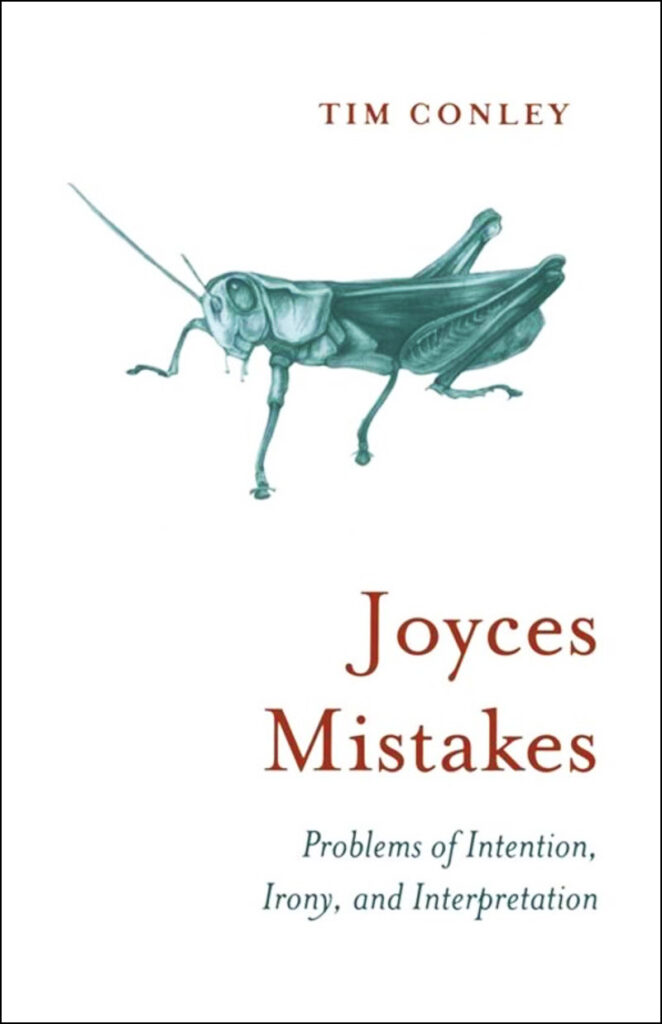
Joyces Mistakes: Problems of Intention, Irony, and Interpretation
By Tim Conley
University of Toronto Press, 2003
An examination of error as a “portal to discovery.” Allen Ruch of the Brazen Head wrote a detailed review of Joyces Mistakes shortly after it was published.
Joycemedia: James Joyce, Hypermedia, and Textual Genetics
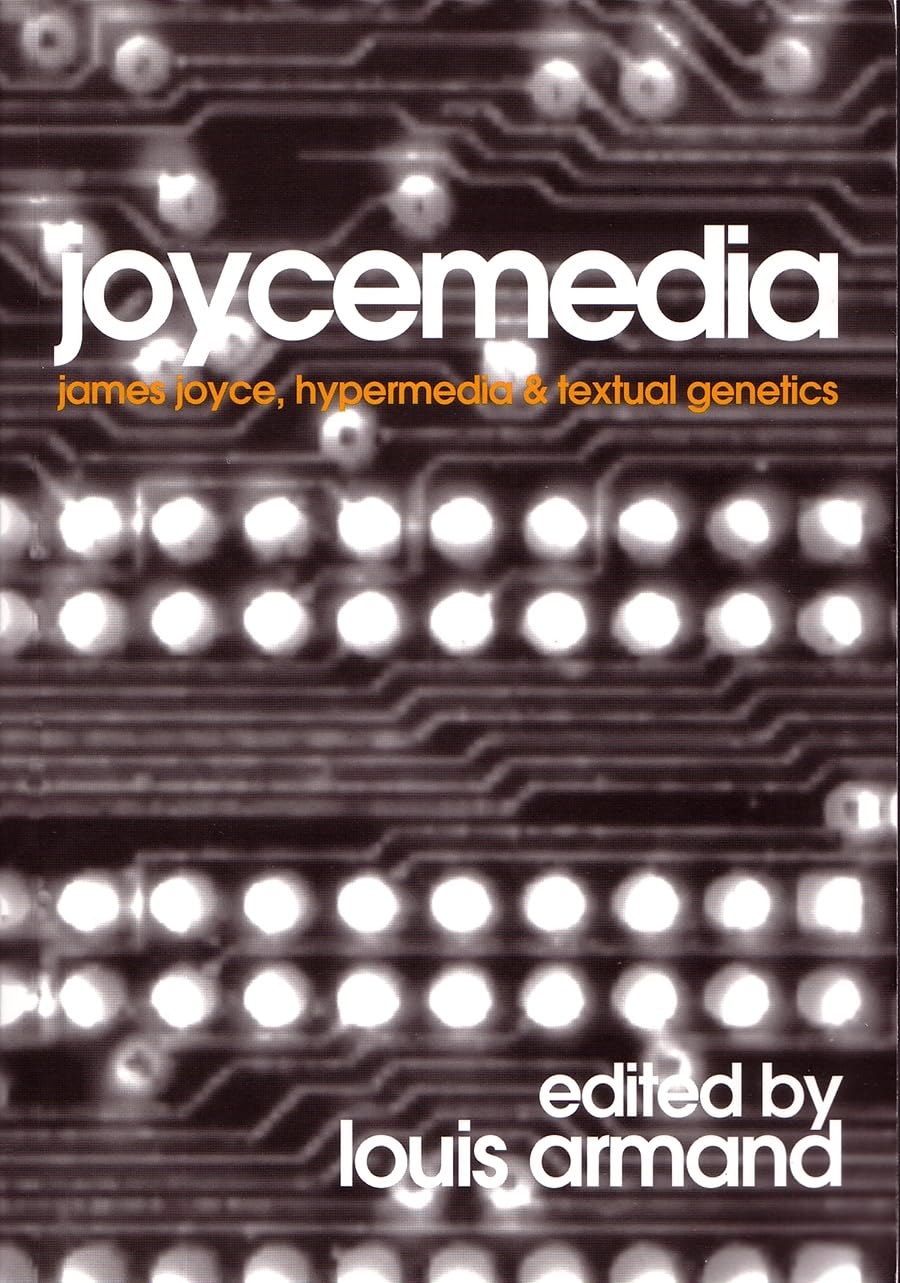
Joycemedia: James Joyce, Hypermedia, and Textual Genetics
By Louis Armand
Syracuse University Press, 2006
Available online at: Internet Archive
Publisher’s Description: There is a rigour and a set of seemingly limitless practical and theoretical demands involved with JoyceMedia that make it a difficult proposition for those more used to the “method” of applying theories that have already been worked out elsewhere. It is arguable, indeed, that after deconstruction, the fusion of genetics and hypertext represents the first major theoretical discourse to have emerged directly out of an engagement with Joyce’s texts. If this is truly the case, then there is every reason to consider that this volume-however tardy its arrival must seem to those who first heard news of it ten years ago-remains nonetheless “in advance” of itself, and that its “news” is, in fact, still to be received.
Contents:
- Louis Armand, “Introduction: Literary Engines”
- Donald F. Theall, “Transformations of the Books in Joyce’s Dream Vision of Digiculture”
- Mark Nunes, “Gaps and Convergences in the Joycean Network”
- Laurent Milesi, “Hyperwake 3D”
- Louis Armand, “From Hypertext to Vortext / Notes on Materiality and Language”
- Daniel Ferrer, “The Work of Joyce in the Age of Hypertextual Production”
- Marlena Corcoran, “Sirens to Cyclops: Momentary Juxtaposition in Genetic Hypertext”
- Michael Groden, “Problems of Annotation in a Digital Ulysses”
- Dirk Van Hulle, “An Electric Stereopticon: Distribution and re-Combination in Joyce’s “Guiltless’ Copybook”
- Thomas Jackson Rice, “I Do Mince Words, Don’t I? Ulysses In Tempore Belli”
- Alan R. Roughley, “Enten: Subjects: Burgess, Shakespeare, Joyce [Text, Intertext, Hypertext, Vortex]”
- Darren Tofts, “Assessing the Green Box Ulysses: Prolegomena to Joycean Hypertextuality”
A Passion for Joyce: The Letters of Hugh Kenner & Adaline Glasheen

A Passion for Joyce: The Letters of Hugh Kenner & Adaline Glasheen
By Hugh Kenner & Adaline Glasheen. Edited by Edward Burns
University College Dublin Press, 2008
Publisher’s Description: Contains all of the extant letters written to each other by the renowned Joyce scholars, Hugh Kenner and Adaline Glasheen, between 1953 and 1984. In these frank letters, we are offered the opportunity to visit the creative process. The letters have been carefully annotated so that we can follow how their ideas are absorbed into their published writings. They do not hesitate to try out ideas on each other and they do not hesitate to express uncomfortable opinions. Their contributions to the common cause spark off each other.
Reviews: Marjorie Perloff’s review of A Passion for Joyce appeared in the Modernism/modernity, Vol. 16, No. 4 (November 2009), pp. 837–839, [Project MUSE paywall]. David Pierce’s review appeared in the James Joyce Quarterly, Vol. 48, No. 1 (Fall 2010), pp. 180–183, [Project MUSE paywall].
The Measureless Time of Joyce, Deleuze and Derrida
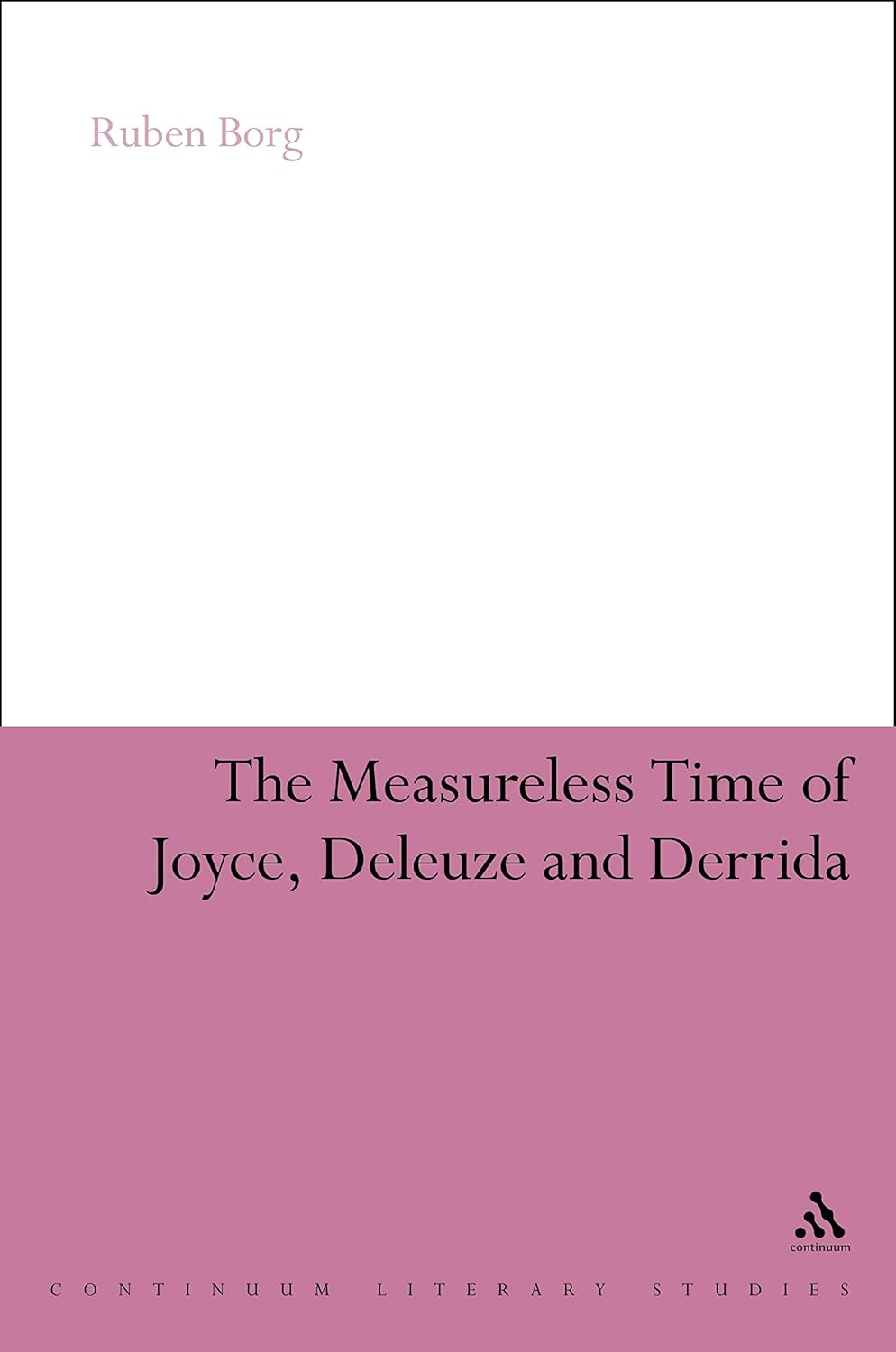
The Measureless Time of Joyce, Deleuze and Derrida
By Ruben Borg
Continuum, 2008
A Flann O’Brien scholar, Ruben Borg is an Associate Professor of English at the Hebrew University of Jerusalem. His research interests include “Irish modernism, posthumanism, cyborg theory, and the dialogue between cinema and literature.” He’s also responsible for a paper in the interesting Cy-Borges, a collection of apparel about Borges and posthumanism.
Publisher’s Description: By examining the relation between time and processes of figuration in James Joyce’s later work, this ground-breaking study identifies his attempt to engage with the philosophical problem of describing time’s characteristic movement whilst acknowledging the impossibility of reducing this movement to anything that can be observed, represented or even experienced. Ruben Borg argues that this problem informs the narrative structure, imagery and complex rhetorical strategies in Finnegans Wake and Ulysses. Drawing on the work of Deleuze and Derrida, Borg challenges the assumption that Joycean time is organised around the idea of a totalising present. Emphasising his treatment of time as a force of measureless passing, Borg offers a better understanding of Joyce’s endeavour to characterise time as a multiplicity that resists representation or objective measurement and its role as a central theme and structural element in his later work.
Reviews: Craig Monk’s review of The Measureless Time of Joyce, Deleuze and Derrida appeared in The Modern Language Review, Vol. 104(2), (2009), pp. 559–561, [RO@M paywall]. The linked abstract serves as a capsule review. Beatrice Boatto’s review appeared in Deleuze Studies, Vol. 8, No. 2 (2014), pp. 299–307, [JSTOR paywall]. She finds it a “brilliant application of deconstructionism to comparative studies in the Humanities (with a striking revision reading of Joyce’s most elaborate masterpiece).”
James Joyce in Context

James Joyce in Context
Edited by John McCourt
Cambridge University Press, 2009
Publisher’s Description: This collection of original, cohesive and concise essays charts the vital contextual backgrounds to Joyce’s life and writing. The volume begins with a chronology of Joyce’s publishing history, an analysis of his various biographies and a study of his many published and unpublished letters. It goes on to examine how his works were received in the main twentieth-century critical and theoretical schools. Most importantly, it places Joyce within multiple Irish, British and European contexts, providing a lively sense of the varied and changing world in which he lived, which formed him, and from which he wrote. The essays collectively show how Joyce was rooted in his times, how he is both a product and a critic of his multiple contexts, and how important he remains to the world of literature, criticism and culture.
Contents:
Part I: Life and Works
Stacey Herbert, “Composition and Publishing History of the Major Works: An Overview”
Finn Fordham, “Biography”
William S. Brockman, “Letters”
Part II: Theory and Critical Reception
John Nash, “Genre, Place and Value: Joyce’s Reception, 1904-1941”
Joseph Brooker, “Post-war Joyce”
Sam Slote, “Structuralism, Deconstruction, Post-structuralism”
Marian Eide, “Gender and Sexuality”
Luke Thurston, “Psychoanalysis”
Gregory Castle, “Post-colonialism”
Dirk Van Hulle, “Genetic Joyce Criticism”
Jolanta Wawrzycka, “Translation”
Eric Bulson, “Joyce and World Literature”
Sean Latham, “Twenty-first-century Critical Contexts”
Part III: Historical and Cultural Contexts
Cheryl Temple Herr, “Being in Joyce’s World”
M. Cullen, “Dublin”
Matthew Campbell, “Nineteenth-century Lyric Nationalism”
Clare Hutton, “The Irish Revival”
Patrick Parrinder, “The English Literary Tradition”
Jean-Michel Rabaté, “Paris”
John McCourt, “Trieste”
Brian Arkins, “Greek and Roman Themes”
Vike Martina Plock, “Medicine”
Michael Levenson, “Modernisms”
Timothy Martin, “Music”
Brian G. Caraher, “Irish and European Politics: Nationalism, Socialism, Empire”
Brandon Kershner, “Newspapers and Popular Culture”
Tim Conley, “Language and Languages”
Fran O’Rourke, “Philosophy”
Geert Lernout, “Religion”
Mark S. Morrisson, “Science”
Maria DiBattista, “Cinema”
Christine Froula, “Sex”
Borges and Joyce: An Infinite Conversation
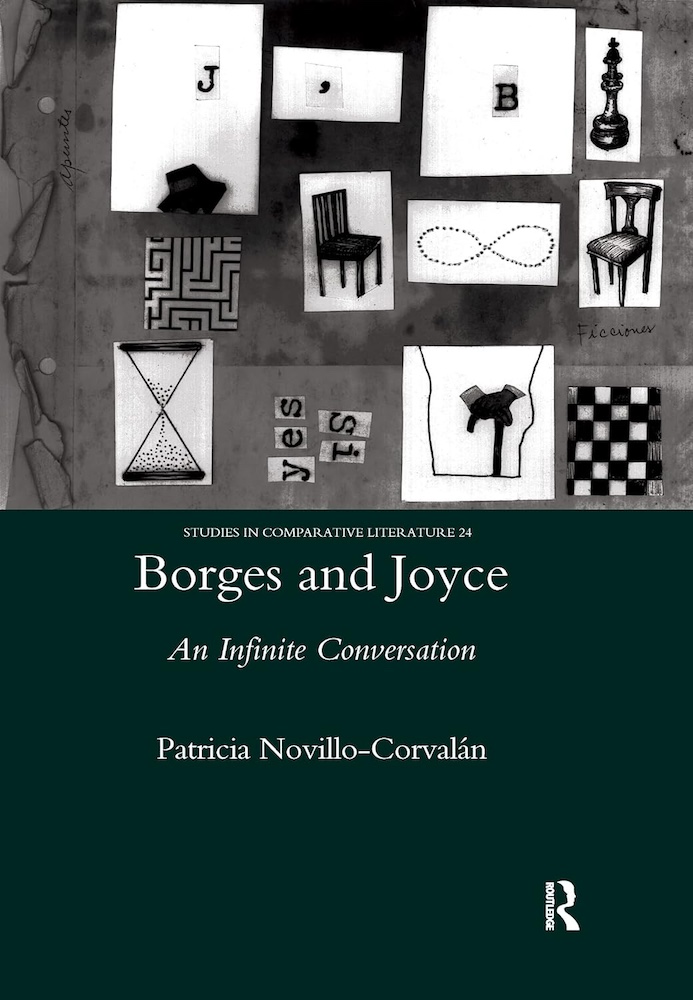
Borges and Joyce: An Infinite Conversation
By Patricia Novillo-Corvalán
Routledge, 2011
Born in Argentina, Patricia Novillo-Corvalán is a professor of Comparative Literature at the University of Kent. Her research “explores issues of identity, nation, empire, race, and gender through the idea of writers’ networks, circulations, afterlives, and receptions, particularly in relation to Latin America, Ireland, India, and British modernism.” Borges and Joyce was her first publication.
Publisher’s Description: In this volume, Novillo-Corvalán brings together two major twentieth-century authors, James Joyce and Jorge Luis Borges. With the chronology of their writing in mind, Novillo-Corvalán focuses on Joyce’s influence upon Borges. She provides a detailed discussion of the reception and translation of Joyce’s work in Latin America, particularly in Buenos Aires (chapter one); she then turns to Borges’s translation of, critical response to, and creative reinterpretation of Joyce’s fiction (chapter two). In comparing and contrasting the two authors, she highlights Joyce’s aesthetic of expansion and Borges’s aesthetic of compression. Although many of Joyce’s texts receive fair attention, her emphasis is on Ulysses, which she reveals as a precursor to a number of Borges’s stories, most memorably “Funes el memorioso” (chapter three). In the second half of the book, Novillo-Corválan reinforces the connection between Joyce and Borges by exploring their shared interest in other literary giants; the volume’s final three chapters are dedicated to an analysis of their critical and creative responses to Homer, Dante and Shakespeare respectively. Borges and Joyce: An Infinite Conversation deftly employs cultural, geographical, biographical, linguistic and literary analysis; in doing so, it provides readers with a better understanding of Joyce, Borges, and the connections between them.
Contents: Borges and Joyce has the following table of contents:
- Introduction: Towards Comparative Literature
- Ulysses in Transit, from Paris to Buenos Aires: The Cross-Cultural Transactions of Larbaud, Borges, and Güiraldes
- Borges’s Reception of Joyce in the Argentine Press
- James Joyce, Author of “Funes the Memorious”
- In Praise of Darkness: Homer, Joyce, Borges
- Architects of Labyrinths: Dante, Joyce, Borges
- Joyce’s and Borges’s Afterlives of Shakespeare
- Conclusion: The Afterlives of James Joyce in Argentina
Reviews: Lucia Boldrini’s review of Borges and Joyce was published in the James Joyce Quarterly, Vol. 49, No. 3/4 (Spring-Summer 2012): pp. 689–692, [JSTOR paywall]. He concludes, “This is an ambitious and satisfying book that illuminates, through the prism of Borges, the work of Joyce and, through Joyce, the work of Borges; by examining both writers, it demonstrates how authors achieve their greatest originality through their engagement with other writers. It is a very welcome and important addition to our libraries.” Ben Bolig’s review appeared in The Modern Language Review, Vol. 108, Part 3 (July 2013): pp. 983–985, [Project MUSE paywall]. The book is also discussed in Jacob Bender’s “The Dead in the Garden of Forking Paths: Joyce, Borges, and their Infinite Ghosts,” which ran in Comparative Literature Studies, Vol. 56, No. 2 (2019): pp. 260–288, [JSTOR paywall].
Zois in Nighttown: Prostitution and Syphilis in the Trieste of James Joyce and Italo Svevo (1880-1920)
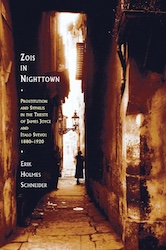
Zois in Nighttown: Prostitution and Syphilis in the Trieste of James Joyce and Italo Svevo (1880-1920)
By Eric Holmes Schneider
Ashgrove Publishing, 2012
Publisher’s Description: What was “Nighttown” to James Joyce? Was it merely the sordid bordello district of Dublin where women could be purchased for a few shillings, or was it instead a “scene”—a place of spectral and epiphanic transfiguration? Why does the figure of the Whore assume such enigmatic and archetypal importance in many of the Irish writer’s texts? How did syphilis, which Joyce contracted at the age of 21, affect his life and writings? Beginning with a survey of the grim reality of prostitution in Trieste where the Irish writer lived, worked and wrote for the better part of sixteen years, and combining extensive research into local police and Austrian government archives with a series of close textual readings and a variety of theoretical approaches, Zois in Nighttown examines Joyce’s life and writings in order to explain why prostitution and syphilis are such pervasive and disruptive discourses in Joyce, and how they are interwoven with many aspects of his personal life and literary works. Zois in Nighttown reaffirms the fundamental importance of Trieste for Joyce, and sheds new light on the many local factors: religious, social, linguistic, political and artistic which combined to influence the writer’s thought and creative processes. The Trieste presented in these pages is neither the Belle Epoque capital of Claudio Magris, nor the picturesque “la Bella Trieste” of standard Joyce biography, but a chaotic and disturbing City of Night which, like its Central European counterparts of Prague and Vienna, provided the essential atmosphere and “culture” for the revolutionary artistic masterpieces it produced.
Reviews: Jean-Michel Rabaté wrote a favorable review of Zois in Nighttown in the Journal of Modern Literature, Vol. 37, No. 1 (2013), pp. 87-89, [JSTOR paywall], comparing it to Moby-Dick: “Just as Melville’s narrative includes an encyclopedic knowledge about whales and whaling, Schneider’s book presents an encyclopedia of whoredom and harlotry.” Kevin Birmingham’s review in the James Joyce Quarterly, Vol. 51, No. 4 (Summer 2014), pp. 715-719, [Project MUSE paywall], offers another endorsement, particularly regarding the sensitive topic of Joyce’s possible syphilis: “Zois in Nighttown…. is a first-rate medical history that treads carefully and capably through this minefield.”
Praharfeast—James Joyce in Prague
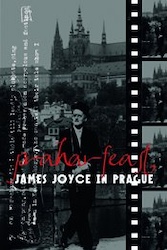
Praharfeast—James Joyce in Prague
Edited by David Vichnar, David Spurr, and Michale Groden
Litteraria Pragensia, 2012
Available online as a free PDF
Publisher’s Description: This collection of essays, drawn from the sessions, plenaries, and roundtable discussions of the XXIInd International James Joyce Symposium that took place in June, 2010, in Prague, covers a range of subjects from the Joyce/Kafka intertext and the Prague Linguistic Circle, to recent advances in the genetic criticism of Joyce.
Contents:
Introduction: PRAHARFEAST: UNPACKING JOYCEAN SUITCASES
By David Vichnar, David Spurr & Michael Groden
Hans E. Jahnke, “Memories of Joyce”
Daniel Ferrer, “The Possible Worlds of Joycean Genetics”
Steve McCaffery, “A Poet’s Joyce”
I. THE JOYCEAN KAFKAESQUE?
Jean-Michel Rabaté, “Joyce or Kafka?”
Richard Brown, “Joyce’s & Kafka’s ‘Sirens’ & the Modernity of the Senses”
Catherine Flynn, “Joyce, Kafka & the Sirens”
Katharine Streip, “Joyce & Kafka: Visual Technologies, Pleasure & Anxiety”
II. JOYCE CENTRALISED
Christine O’Neill, “From Náchod to Dublin via Prague & Brno: A European Wakean Called Petr Škrabánek”
Vincent J. Cheng, “Joyce, Kundera & National Forgetting”
Katarzyna Bazarnik, “Who’s He When He’s at Home? The Figure of the Central-European Jew in Joyce’s & Perec’s Fiction”
Mary Libertin, “Two Planes Joined: The Turn of the Screw of Synecdoche in Joyce & Jakobson”
Liliane Rodriguez, “From Mozart to Jakobson: The Cubist Don Giovanni in Joyce’s Ulysses”
Benoît Tadié, “Linguistic Disorder in Joyce & Jakobson”
III. LOTS OF FUN AT FINNEGANS WAKE
Robbert-Jan Henkes, “Editing the Wake”
Lawrence Stanley, “In the Unbewised: Revision & Construction of Degree Zero in ‘Anna Livia Plurabelle’”
Cliff Mak, “The Beast of Boredom: Letting Joyce’s Ass Be in Finnegans Wake”
Mia McIver, “Ash in the Troposphere: The Century of Joyce, or, Infrareading”
Cat Gubernatis Dannen, “Genghis Is Ghoon for You: Guinness, Colonialism & Capitalism in Finnegans Wake”
IV. THE JOYCE OF PLURABILITIES
Onno Kosters, “Not-So-Smooth Operator: Having the Nerves in ‘Eumaeus’”
Thomas Jackson Rice, “Joyce the American”
Greg Winston “Talking about Violent Exercise: Joyce, Sports & Militarization”
André Topia, “Inchoate Joyce: Floating Frontiers, Blurred Cycles”
Useless Joyce: Textual Functions, Cultural Appropriations
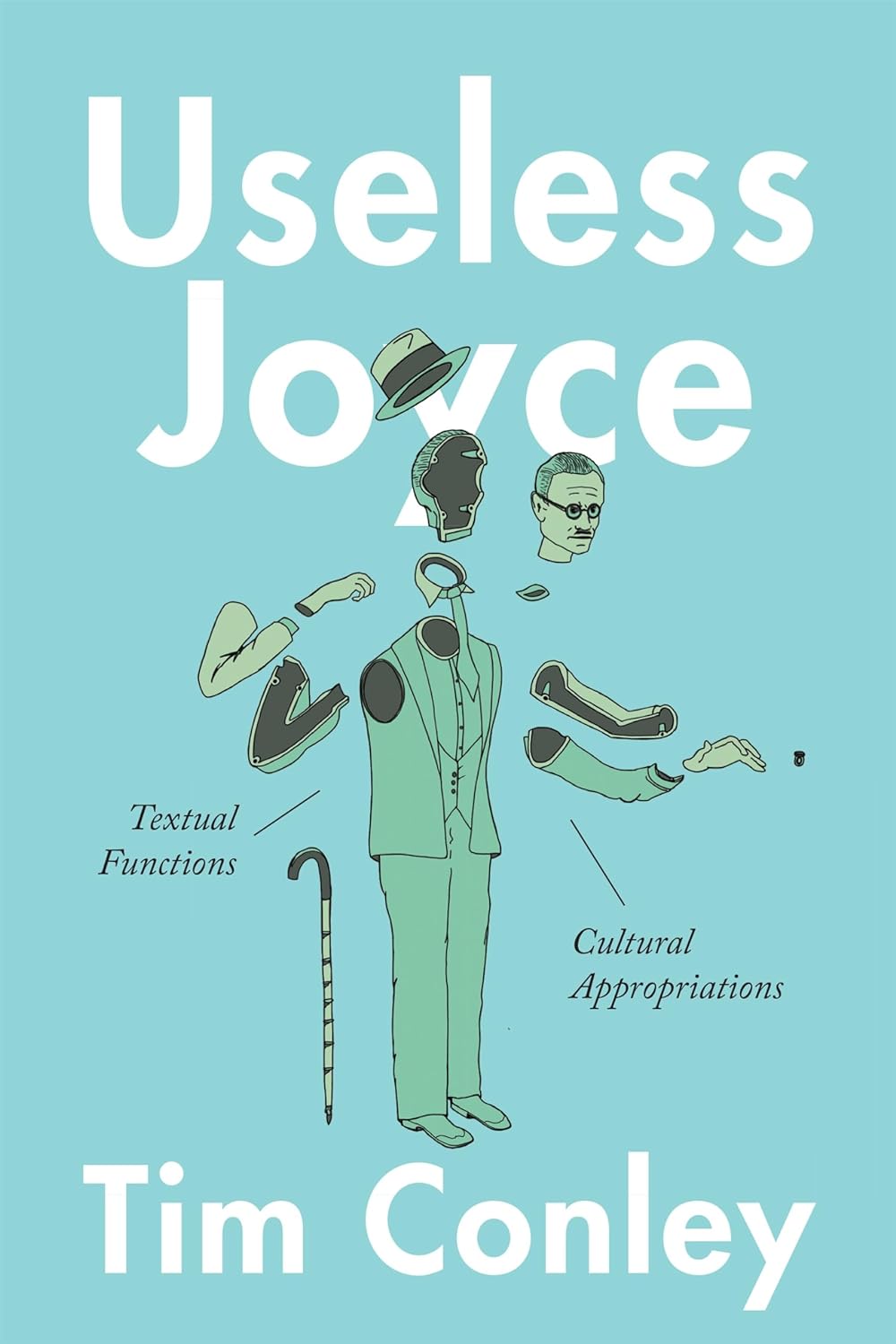
Useless Joyce: Textual Functions, Cultural Appropriations
By Tim Conley
University of Toronto Press, 2017
Publisher’s Description: Tim Conley’s Useless Joyce provocatively analyses Joyce’s Ulysses and Finnegans Wake and takes the reader on a journey exploring the perennial question of the usefulness of literature and art. Conley argues that the works of James Joyce, often thought difficult and far from practical, are in fact polymorphous meditations on this question. Examinations of traditional textual functions such as quoting, editing, translating, and annotating texts are set against the ways in which texts may be assigned unexpected but thoroughly practical purposes. Conley’s accessible and witty engagement with the material views the rise of explication and commentary on Joyce’s work as an industry not unlike the rise of self-help publishing. We can therefore read Ulysses and Finnegans Wake as various kinds of guides and uncover new or forgotten “uses” for them. Useless Joyce invites new discussions about the assumptions at work behind our definitions of literature, interpretation, and use.
Reviews: Eleni Loukopoulou’s review of Useless Joyce appeared in the James Joyce Quarterly, Vol. 55, No. 3–4 (Spring–Summer 2018), pp. 461–465, [Project MUSE paywall]:
Despite the provocative characterization “useless Joyce” in the title of his book, Tim Conley sets out to explore the usefulness of Joyce’s texts. As he argues, Joyce is “a most ‘useful’ writer to examine in a discussion of what it means to assert that a text is useful or that a reader ‘uses’ a text”. Thus, he approaches the question of use in Joyce’s work through diverse ways and offers a coherent narrative.
Joyce in Court

Joyce in Court
By Adrian Hardiman
Head of Zeus Press, 2017
A founding member of An Páirtí Daonlathach, the “Progressive Democrats” of 1985-2009, Justice Adrian Hardiman (1951-2016) was a lawyer and politician from Dublin. In 2000 he was appointed to the Irish Supreme Court, a position he held until his death. According to the Irish Times, “He was progressive on social issues, protective of civil liberties and individual freedoms and hostile to any attempt by the State to over-extend the limits of its role.” A powerful advocate for the Irish language, Hardiman was also a lifelong Joycean.
Publisher’s Description: Adrian Hardiman spent years researching Joyce’s obsession with the legal system, and the myriad references to notorious trials in Ulysses and Finnegans Wake. Joyce was fascinated by and felt passionately about miscarriages of justice, and his view of the law was colored by the potential for grave injustice when policemen and judges have too much power. Hardiman recreates the colorful, dangerous world of the Edwardian courtrooms of Dublin and London, where the death penalty loomed over many trials. He brings to life the eccentric barristers, corrupt police and omnipotent judges who made the law so entertaining and so horrifying. This is a remarkable evocation of a vanished world, though Joyce’s skepticism about the way evidence is used in criminal trials is still highly relevant.
Reviews: Carey Mickalites’ review of Joyce In Court appeared in the James Joyce Quarterly, Vol. 55, No. 3–4 (Spring–Summer 2018), pp. 467–471, [Project MUSE paywall]. Colm Tóibín reviewed the book for The Guardian, 6 July 2017.
James Joyce and the Matter of Paris
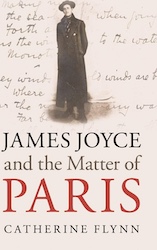
James Joyce and the Matter of Paris
By Catherine Flynn
Cambridge University Press, 2019
Publisher’s Description: In James Joyce and the Matter of Paris, Catherine Flynn recovers the paradigmatic city of European urban modernity as the foundational context of Joyce’s imaginative consciousness. Beginning with Joyce’s underexamined first exile in 1902-03, she shows the significance for his writing of the time he spent in Paris and of a range of French authors whose works inflected his experience of that city. In response to the pressures of Parisian consumer capitalism, Joyce drew on French literature to conceive a somatic aesthetic, in which the philosophically disparaged senses of taste, touch, and smell as well as the porous, digestive body resist capitalism’s efforts to manage and instrumentalize desire. This book resituates the most canonical of Irish modernists in a European avant-garde context while revealing important links between Anglophone modernism and critical theory.
Reviews: Xander Ryan’s review of James Joyce and the Matter of Paris appeared in Partial Answers: Journal of Literature and the History of Ideas, Vol. 20, No. 2 (June 2022), pp. 378–382, [Project MUSE paywall]
Flynn’s overall argument comprises three interlocking elements. The first is the question of aesthetic distance and the artist’s relation to the material world…. The second element in Flynn’s argument is her characterisation of Joyce’s encounter with Paris as an “overwhelming sensory experience,” a flood of sensation that he identified as being symptomatic of consumer capitalism and urban modernity. The third element is intertextual: Flynn examines how Joyce’s encounter with Paris was mediated and shaped by the city’s representation in French literature, homing in on texts by authors including Flaubert, Baudelaire, Apollinaire, Nerval, and Rimbaud.
Flynn combines these three strands to develop a thesis about “sentient thinking” in Joyce’s fiction, analyzing passages in which characters interact with one another and their urban environment by way of the senses, particularly “the ‘lower’ senses of smell, taste, and touch”…
CONTINUE TO > General Joyce Criticism 2020-Present
Joyce Criticism
[Main Page | General Criticism | Dubliners | Portrait | Ulysses | Finnegans Wake]
Author: Allen B. Ruch
Artwork: Loui Jover
Last Modified: 20 August 2024
Main Joyce Page: The Brazen Head
Contact: quail(at)shipwrecklibrary(dot)com

